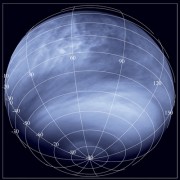So far, ozone layers have only been found on Earth and Mars, so the new discovery is surprising. It may contribute to astronomers in the search for life on other planets

The Venus Express spacecraft of the European Space Agency (ESA) discovered an extremely thin ozone layer on Venus. The layer is thousands of times thinner than that of the Earth.
So far, ozone layers have only been found on Earth and Mars, so the new discovery is surprising. It may contribute to astronomers in the search for life on other planets.
The European Space Agency can distinguish the ozone layer when focusing on stars that are through the layer of Venus - the distant stars appear more "faded". The atmosphere of the star, located between the distant stars and the spacecraft, absorbs part of the light of the stars, and thus its existence can be proven. The atmosphere consists of molecules of 3 oxygen atoms.
According to computer models, the atmosphere on Venus was formed when sunlight broke up carbon dioxide molecules, releasing the oxygen atoms. The atoms drifted into the atmosphere and formed diatomic and triatomic molecules.
"The discovery allows us to understand the chemistry of the star's atmosphere," says Frank Montmasin, who led the research. Also, it contributes in the study of life on other planets. Ozone layer was previously located only on Earth and Mars. On Earth, it is a necessary commodity for the formation of life, because the layer absorbs most of the harmful rays of the sun that are sent to the planet. Other studies even indicate that the atmosphere is a product of life itself.
The formation of the atmosphere on Earth began about 2.4 billion years ago. The reasons for its formation are not known for sure, but science does not dispute that certain microbes that emit oxygen play a central role in the process.
According to the scientists, they will be able to use the same method to study distant planets and find out if they might be inhabited. However, they point out, the amount of atmosphere in the planets can reveal crucial details.
An amount of ozone as small as can be found on Mars indicates that it was not produced by animals. On the surface of Mars, the material is formed as a result of the breaking of molecules by the sun, as is the case on Venus.
Theoretical astrobiologists believe that in order for life to form on the planet, the ozone layer should be at least 20% thicker than that on Earth.

3 תגובות
curious,
In simple language, two main pressure forces are exerted on each planet, inward (gravitational force)
and outwards (release of trapped gases) and this is what causes the star to assume the shape of an ellipse (the star does look like a perfect sphere, but it really isn't, so it is correct to call it an ellipse)
Yael
A layman's question, and curious, so please be patient.
Why are all the stars round?
Why, in the process of creation and birth, was a flat, square or any other shape not created?
Thanks
Stunning,
Raises a lot of questions:
How do they discover the ozone, through the absorption lines of the molecule in the spectrum passing through the atmosphere?
It is also interesting how they estimate the amount of ozone in the atmosphere and the thickness of the atmosphere?
I assume that this requires long-term monitoring or a wide-angle detector of the planet.
Why did we have to wait for the Venus spacecraft to detect the atmosphere? Probably the amount of light coming through us
The atmosphere is small and you have to get really close to the planet.
A layman's question, how was carbon dioxide created on Venus, which according to the theory is the source of ozone?